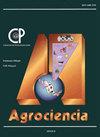EFFECT OF ORANGE PEEL BIOCHAR ON THE FERTILITY OF THREE TYPES OF SOIL
IF 0.5
4区 农林科学
Q4 AGRICULTURE, MULTIDISCIPLINARY
引用次数: 0
Abstract
The orange juice production industry in Veracruz generates a large amount of peel waste, which is both an economic and environmental problem. One way to repurpose these residues is to create biochar, which can be used in agriculture to improve fertility and crop productivity. The aim was to determine how the addition of orange biochar affected the physical and chemical properties of different soils, as well as corn growth (Zea mays L.). The experimental design was completely randomized in factorial arrangement (3 x 4): three soil types (clay loam, sandy, and sandy loam), four biochar doses (0, 18, 90, and 180 equivalent to Mg ha-1), and nine replicates per treatment (n = 108). The highest biochar dose presented significant differences (p ≤ 0.05) in almost all soil physical and chemical variables, except for moisture holding capacity, which varied significantly only in the sandy loam soil with the medium and high doses. In the clay loam soil, the higher dose significantly reduced stem width, aerial biomass, and leaf area. In sandy soil, the medium dose increased stem height and root biomass. In addition, in the sandy loam soil, the highest dose increased stem height and width. The remaining growth variables showed no significant differences between doses or soil types. In conclusion, the use of this biochar altered the physical and chemical properties of the three different soils, as well as having a significant impact on some maize growth variables.橘皮生物炭对三种土壤肥力的影响
韦拉克鲁斯州的橙汁生产行业会产生大量果皮废料,这既是一个经济问题,也是一个环境问题。重新利用这些残渣的一种方法是制造生物炭,生物炭可用于农业,提高肥力和作物产量。实验的目的是确定添加橘子生物炭如何影响不同土壤的物理和化学特性,以及玉米(Zea mays L.)的生长。实验设计采用完全随机的因子排列(3 x 4):三种土壤类型(粘壤土、沙土和沙壤土),四种生物炭剂量(0、18、90 和 180,相当于毫克/公顷-1),每个处理九次重复(n = 108)。最高生物炭剂量在几乎所有土壤物理和化学变量中都有显著差异(p ≤ 0.05),但持水能力除外,只有中剂量和高剂量的砂壤土持水能力有显著差异。在粘壤土中,高剂量显著减少了茎宽、气生生物量和叶面积。在沙壤土中,中等剂量增加了茎高和根部生物量。此外,在沙壤土中,最高剂量增加了茎高和茎宽。其余生长变量在不同剂量或土壤类型之间没有明显差异。总之,使用这种生物炭改变了三种不同土壤的物理和化学特性,并对一些玉米生长变量产生了显著影响。
本文章由计算机程序翻译,如有差异,请以英文原文为准。
求助全文
约1分钟内获得全文
求助全文
来源期刊

Agrociencia
农林科学-农业综合
CiteScore
0.50
自引率
33.30%
发文量
51
审稿时长
18-36 weeks
期刊介绍:
AGROCIENCIA is a scientific journal created and sponsored by the Colegio de Postgraduados. Its main objective is the publication and diffusion of agricultural, animal and forestry sciences research results from mexican and foreign scientists. All contributions are peer reviewed. Starting in the year 2000, AGROCIENCIA became a bimonthly and fully bilingual journal (Spanish and English versions in the same issue). Since 2007 appears every month and a half (eight issues per year). In addition to the printed issues, the full content is available in electronic format.
 求助内容:
求助内容: 应助结果提醒方式:
应助结果提醒方式:


